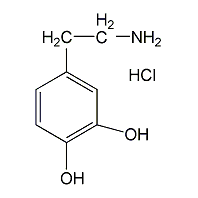
Structural formula
| Business number | 01C7 |
|---|---|
| Molecular formula | C8H11NO2·HCl |
| Molecular weight | 189.64 |
| label |
dopamine hydrochloride, 2-(3,4-Dihydroxyphenyl)ethylamine hydrochloride, 3,4-Dihydroxyphenethylamine hydrochloride, 3-Hydroxytyramine hydrochloride, 4-(2-Aminoethyl)-1,2-benzenediol hydrochloride, Dopamine hydrochloride, (HO)2C6H3CH2CH2NH2·HCl |
Numbering system
CAS number:62-31-7
MDL number:MFCD00012898
EINECS number:200-527-8
RTECS number:UX1092000
BRN number:3656720
PubChem number:24277897
Physical property data
1. Appearance: White needle-like crystals or crystalline powder
2. Density (g/mL, 25/4℃): Uncertain
3. Relative vapor density (g/mL, air=1): Uncertain
4. Melting point (ºC): 248-250 (lit.)
5. Boiling point (ºC, normal pressure): Uncertain
6. Boiling point (ºC, 5.2kPa): Uncertain
7. Refractive index: Uncertain
8. Flash point (ºC): Uncertain
9. Specific rotation (º): Uncertain
10. Autoignition point or ignition temperature (ºC): Uncertain
11. Vapor pressure (kPa, 25ºC): Uncertain
12. Saturated vapor pressure (kPa, 60ºC): Uncertain
13. Heat of combustion (KJ/mol): Uncertain
14. Critical temperature (ºC): Uncertain
15. Critical pressure (KPa): Uncertain
16. Oil-water (octanol/water) distribution Log value of coefficient: Uncertain
17. Explosion upper limit (%, V/V): Uncertain
18. Explosion lower limit (%, V/V): Uncertain
19. Solubility: Easily soluble in water, soluble in methanol and hot 95% ethanol, soluble in sodium hydroxide solution, insoluble in ether, chloroform and benzene
Toxicological data
Acute toxicity:
Oral LD50 4361mg/kg(mus)
2859mg/kg(rat)
Main irritant effects:
On skin: Irritation to skin and mucous membranes.
On eyes: Irritation effects
Sensitization: No known sensitizing effects.
Ecological data
General notes
Water hazard level 1 (German regulations) (self-assessment via listEstimated) This substance is slightly harmful to water.
Do not allow undiluted or large amounts of product to come into contact with groundwater, waterways or sewage systems.
Do not discharge materials into the surrounding environment without government permission.
Molecular structure data
1. Molar refractive index: 43.10
2. Molar volume (cm3/mol): 122.7
3. Isotonic specific volume (90.2K): 342.9
4. Surface tension (dyne/cm): 60.8
5. Polarizability (10-24cm3): 17.08
Compute chemical data
1. Reference value for hydrophobic parameter calculation (XlogP): None
2. Number of hydrogen bond donors: 4
3. Number of hydrogen bond acceptors: 3
4. Number of rotatable chemical bonds: 2
5. Number of tautomers: 18
6. Topological molecule polar surface area 66.5
7. Number of heavy atoms: 12
8. Surface charge: 0
9. Complexity: 119
10. Number of isotope atoms: 0
11. Determine the number of atomic stereocenters: 0
12. Uncertain number of atomic stereocenters: 0
13. Determine the number of chemical bond stereocenters: 0
14. Number of uncertain chemical bond stereocenters: 0
15. Number of covalent bond units: 2
Properties and stability
None yet
Storage method
This product should be kept sealed, dry and protected from light.
Synthesis method
Obtained from the ring-opening of piperonethylamine. Add piperonoethylamine and phenol to the reaction pot, cool it, slowly add hydrochloric acid, raise the temperature to 110°C and reflux for 12-44 hours. After the reaction reaches the end point, cool slightly, add water and stir evenly. Let stand and separate the phenol layer. The water layer was extracted with isopropyl acetate. The extracted water layer was evaporated to dryness under reduced pressure (8.0kPa). Then 1/2 amount of ethanol and hydrochloric acid were added and heated to dissolve. Cool, crystallize, filter, wash the filter cake with ethanol, and dry to obtain the finished product. The yield is 74%.
Purpose
This product is a vasopressor and a biochemical reagent. Dopamine receptor agonists can excite the heart, increase renal blood flow, and are used for hemorrhagic, cardiac asthenia, and septic shock.


